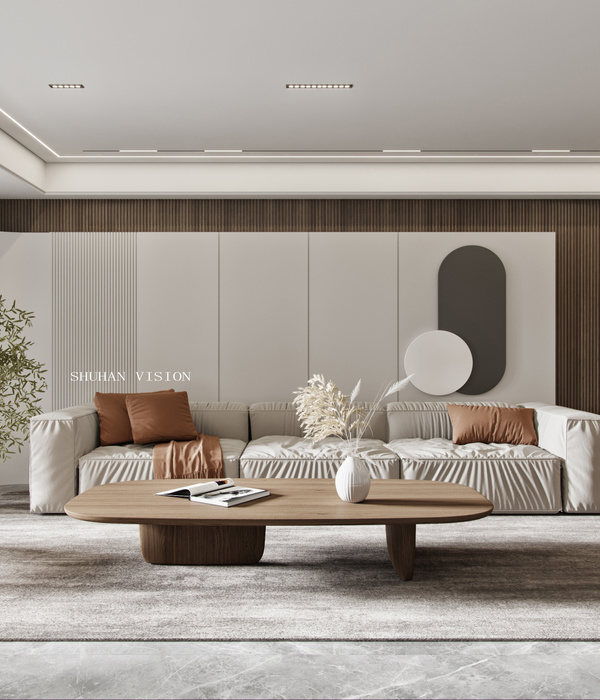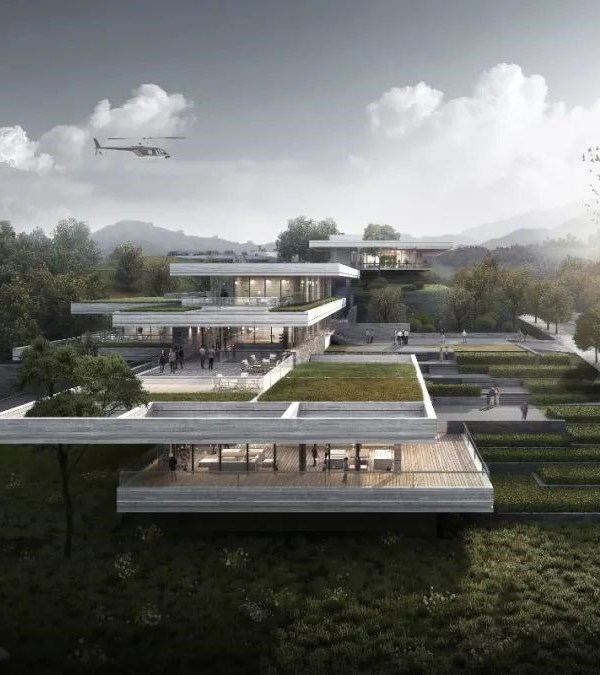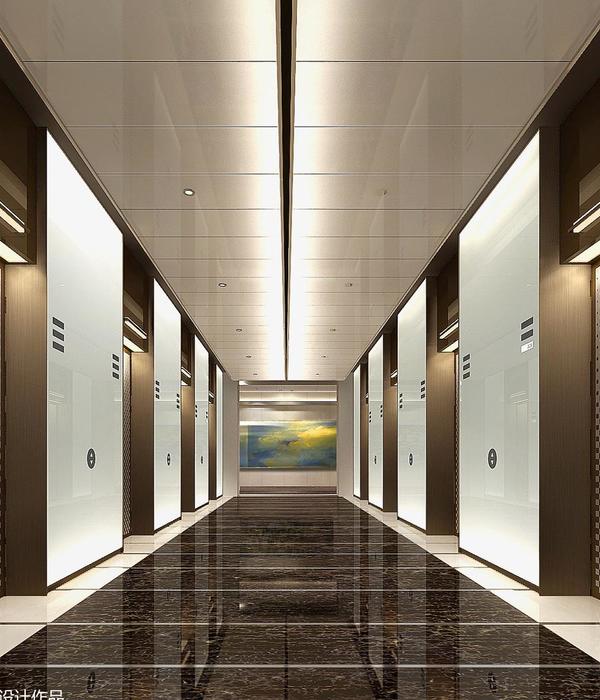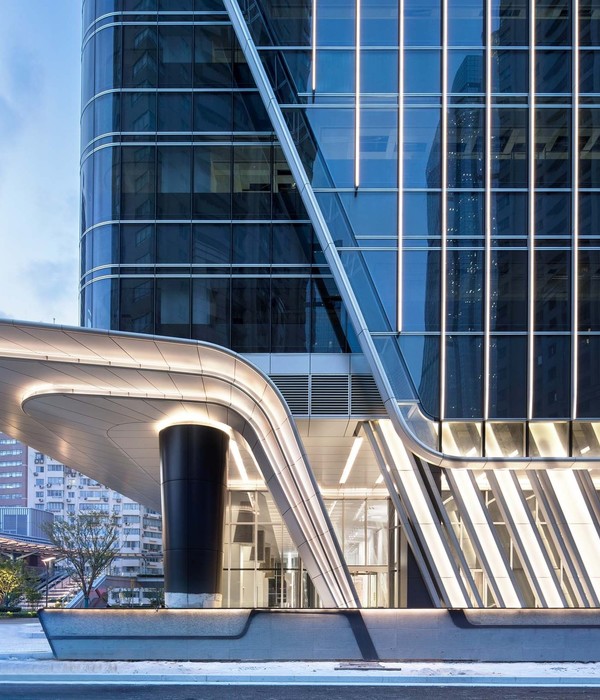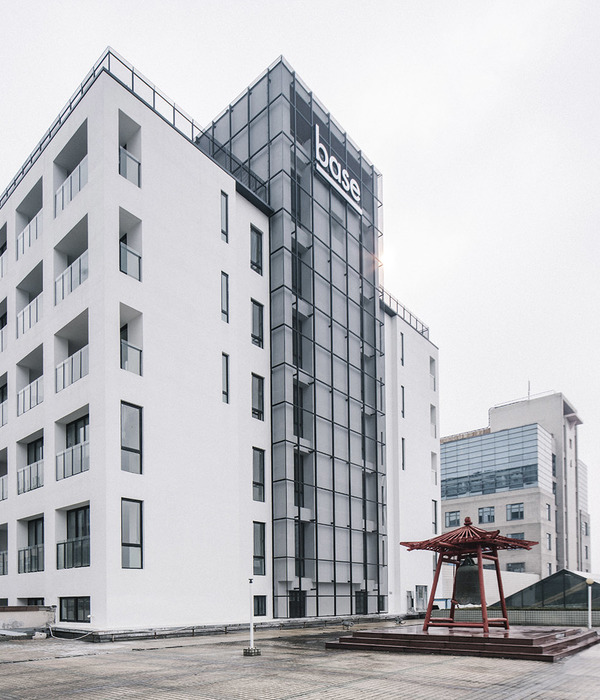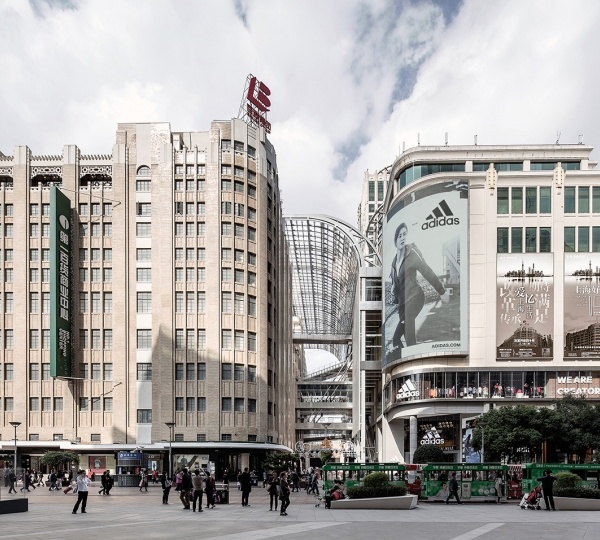曾几何时,我们的美学更多表达出“贵族”和“书卷气”的口味。这可能是一种更安全、更具有形式感的空间意象,但却使我们在其中的生活变得扁平和概念化。
At one time, our aesthetics tended to express a sense of nobility and refinement. This may have been a safer and more formal image, but it can also make our lives feel flat and abstract.
▼项目概览, project overview ©存在建筑摄影
▼项目外观, exterior of the project©存在建筑摄影
在营建过程中,设计师易平一开始就决计反对一切人作的所谓 “氛围东方”,转而使用我们耳熟能详的日常话语,创造出有体温、能卸下生活的沉疴日常、非正式的社交空间,让人感受到别样的轻松、畅快。
In the construction process, the designer Yi Ping decided to oppose anything labeled as “Oriental ambiance” from the outset. Instead, he opted to utilize familiar everyday items to create a warm, free, and informal social space, allowing people to experience a unique sense of relaxation and joy.
▼俯瞰项目, overlook of the project ©存在建筑摄影
▼俯瞰项目, overlook of the project ©存在建筑摄影
▼屋顶特写, roof detail ©存在建筑摄影
出身和成长于川南地域的易平,对他影响至深的是川南场镇的人来人往和市井的随意和随之而来的生活噪声,这些日常生活的场景尽管有情感的温度,但今天随着时代的发展已经渐行渐远,那种粗放、憨呆兼而有之的人情味却如同磁石一般,在易平心中成为永恒的记忆。于是,设计师带着这样剥落、有噪点的记忆开始了“沏茶师“设计构思!
Yi Ping, the designer who was born and raised in southern Sichuan, was deeply influenced by the bustling crowd and lively marketplace atmosphere of the southern Sichuan town. Although these daily scenes were emotionally rich, they have gradually faded with the passage of time. However, the rustic, simple, and heartfelt charm of the place has remained like a magnet in Yi Ping’s mind, becoming an eternal memory. Thus, the designer embarked on the conceptualization of “Chichas” with these faded yet nostalgic memories.
▼二层平台, platform ©存在建筑摄影
临街茶铺
Tea shop on the street
首先,他设定了川南场镇的临街茶铺作为“沏茶师”消费场景,这时,成都天空中少见的阳光倾洒进院落,成为空间的重要取光方式,仿夯土围墙和沿街区形成的古旧、倾斜的屋檐形成豁口,规定光线以折射的方式进入室内。
Firstly, Yi Ping chose the street-side tea shop in the southern Sichuan town as the setting for “Chichas” consumption scene. When the rare sunlight in Chengdu pours into the courtyard, it becomes the primary source of light for the space. The imitation loam walls and the old sloping roofs along the street form a breach, allowing light to enter the interior through refraction.
▼仿夯土围墙和倾斜的屋檐, loam walls and the old sloping roofs ©存在建筑摄影
▼阳光倾洒进院落, light flows into the courtyard©存在建筑摄影
走进麓湖“沏茶师”,恍如走进开敞的院落,夯土墙围合成尺度适宜、又可越墙沟通的场所,墙与墙之间留有交通通道,它与麓湖岛商业街区的喧嚣结合在一起,形成当代的生活噪声,动线生动、兴味盎然,具有整体感。
Upon entering “Chichas” at Lu Lake, one feels as if stepping into an open courtyard. The loam walls enclose a space of suitable scale, with communication channels between walls for interaction. The space blends the hustle and bustle of Lu Lake Island’s commercial district, creating a contemporary urban noise, with clear and dynamic circulation routes, vibrant and cohesive.
▼室内空间, interior space©存在建筑摄影
▼室内空间, interior space©存在建筑摄影
体块切割
Mass cutting
设计师在屋檐下的中庭设计了一处步道楼梯,楼梯的形式简单,以此回应了民间具有亲切感的交通路径,把室内一楼和二楼连接成一体,让空间体量在整体的视线下变得丰满而多姿,每个角落变成有节奏和控制的有机体,自然而不做作,节奏怡然。
Yi designed a footpath stair beside the atrium under the roof, which is very simple, in response to a folk path full of intimacy. He connected the 1st and 2nd floors indoors to make the space appear plentiful and varied in the overall view. Every corner has become a rhythmic and controlled organism, natural yet not artificial, with a pleasant rhythm.
▼步道楼梯, footpath stair©存在建筑摄影
▼步道楼梯细部, footpath stair detail ©存在建筑摄影
在楼梯的切割下,呆板的现代建筑空间被切割成不规则的体块,但是气息却属于整体空间所共享,设计师仅仅利用座位朝向关系,将关注焦点落在与其同来的人身上,空间的公众与私密就此分开,设计师顺势将角落空间的活力激发出来,让它成为具有安定感的角落空间,抚慰希望与社会相处的人的心灵。
Because of the slicing of the stairs, the rigid modern architectural space is cut into irregular blocks, but the atmosphere still belongs to the shared whole space. The designer simply used the orientation of the seats to focus on the people accompanying us. The public and private aspects of the space are thus separated. The designer has effectively brought out the vitality of the corner space, turning it into a tranquil corner space that comforts individuals seeking to engage with society.
▼具有安定感的角落空间, a tranquil corner space©存在建筑摄影
落座姿态
Sit-down position
沿楼梯和阳光拾级而上,进入二楼,这里,设计师用一个“观景平台”作为迂回空间,人们可以在此停歇观赏麓湖岛街区的人来人往,也可以到户外檐上座位,在屋顶上晒太阳、360度观看麓湖岛的全貌。屋顶晒太阳,这本是川南人独有的休闲、获取冬日暖阳的方式,被设计师引用致“沏茶师”落座的姿态,不得不佩服设计师的想象力恣肆却恰如其分。
Ascending the stairs bathed in sunlight, we reach the second floor where the designer has cleverly incorporated a “viewing platform” as a meandering space. Here, visitors can pause to enjoy the bustling activity of the Lu Lake Island neighborhood. Additionally, they can relax on outdoor eave seats, basking on the rooftop while taking in a 360-degree view of Lu Lake Island. Sunbathing on the roof, originally a leisurely way for people in southern Sichuan to soak up the winter sun, has now been ingeniously integrated into the seating arrangement at “Chichas” by the designer. One cannot help but admire the designer’s bold yet balanced imagination.
▼户外檐上座位, outdoor eave seats©存在建筑摄影
▼观景空间,viewing space©存在建筑摄影
▼观景平台,viewing platform©存在建筑摄影
这时,我们可以仔细查看脚下的坡形屋面,这是自然起伏的室外檐顶,设计师用钢架仿照自然的扭曲作为支撑,覆盖上云南大理地区常用的屋顶木板和木皮,它们源自民间的叠盖檐口,具有极强的柔韧、防雨和抗晒性能,古旧的外观更有民间的烟火气。远观和近看,都与楼盘的现代感和科技化形成强烈的反差又具有奇妙的融合度,让人对时光飞逝有一种莫名的忧伤,对未来有一种独特的期盼。
At this point, we can examine the sloping roof beneath our feet with care. It is a naturally undulating outdoor eave, where the designer has used a steel frame mimicking natural twists as support, covered with roof boards and wood veneer commonly used in the Dali region of Yunnan. These materials are inspired by traditional overlapping eaves, known for their excellent flexibility, waterproofing, and sun protection properties. The aged appearance exudes a rustic charm. Whether viewed from afar or up close, it creates a striking yet harmonious contrast with the modern and technological aspects of the Lu Lake development, evoking a sense of bittersweet nostalgia for the passage of time and a unique anticipation for the future.
▼屋顶细部,roof detail ©存在建筑摄影
室内气韵
Interior charm
在二楼的室内,设计师用老茶铺的标志——老虎灶组织出整体动线,座位在空间中或聚合或分散,既使空间具有热闹、喧嚣的氛围,又保证作为社交空间私密性的需求,设计师在人的驻留与移动方式上破费周章,动线在不干扰客人落座的前提下,灵活、曲折而贯通,保证了空间的趣味性和留住客人的气韵。正因为如此,业主将这个项目命名为“沏茶师・遊园”。
On the second floor interior, the designer has cleverly utilized the symbol of an old tea shop, the tiger kitchen range, to create a cohesive flow throughout the space. Seats are arranged in a way that some are clustered together while others are more scattered, striking a balance between a lively, bustling atmosphere and the need for privacy in a social space. The designer meticulously considered how people would move and pause within the space, ensuring that the dynamic flow remains flexible, meandering, and uninterrupted to maintain the space’s charm and allure for guests. It is due to these thoughtful design choices that the owner has aptly named the project “Chichas, Strolling the garden”.
▼老虎灶,the tiger kitchen range©存在建筑摄影
▼二层空间,upper level space©存在建筑摄影
▼二层座位区,upper level seating area©存在建筑摄影
▼细部,detail©存在建筑摄影
任何一个空间,如果只有怀旧而不会向未来看,必然会衰败。因此,在麓湖岛“沏茶师”的空间形态设置中,设计师融入进被年轻一代消费者热捧的咖啡馆、酒吧的元素和中式民间的陶艺……这一切在设计师手中被处理得自然而妥帖,毫无拼贴的痕迹。
If a space only dwells on nostalgia without looking towards the future, it is bound to deteriorate. Therefore, in the design of the “Chichas” space at Lu Lake Island, the designer has seamlessly incorporated elements of cafes, bars, and Chinese folk pottery that are popular among the younger generation. These elements have been artfully integrated by the designer to create a natural and harmonious blend, devoid of any visible traces of patchwork or forced combinations.
▼空间的趣味性,space’s charm©存在建筑摄影
▼空间氛围,space atmosphere©存在建筑摄影
这是一个值得称道的设计。正如建筑大师格伦・马库特说的那样:“我们当然需要理解问题,但最首要的问题是要知道自己的位置,才能看见并找到最合适的方向——而不是最时髦的方向。”
This is a commendable design. As the architect Glenn Murcutt once said, “Certainly, we need to understand the problem, but the most crucial aspect is to know our own position in order to see and find the most suitable direction – not necessarily the trendiest one.”
▼细部,detail©存在建筑摄影
▼一层平面,ground floor plan©易禾上品
▼二层平面,first floor plan©易禾上品
▼立面 1,elevation 1©易禾上品
▼立面 2,elevation 2©易禾上品
项目名称:沏茶师CHICHAS·遊园
项目类型:茶饮空间
主创设计:易平/易禾上品 张武/沏茶师
完成年份:2023
设计团队:张裕楚、陈洪志、刘东川、李显龙
项目地址:成都市麓湖北街麓坊中心
建筑面积:280㎡
摄影版权:存在建筑摄影
合作方:卧羊照明 张帆研物
客户:沏茶师
材料:夯土、木瓦、涂料、金砖石
文案:张轶青
Project name:CHICHAS·Strolling The Garden
Project type:Tea house
Design in charge:YiPing(YID), ZhangWu(CHICHAS)
Completion Year:2023
Design Team:ZhangYuchu,ChenHongzhi,LiuDongchuan,LiXianlong
Project location:Luxezone,Chengdu
Gross built area:280 ㎡
Photo credit: ARCHEXIST
Partner:Woy Lighting,ZhangFan
Clients:CHICHAS
Materials:loam,shingle,coating,gold masonry
Copywriting:ZhangYiqing
{{item.text_origin}}




